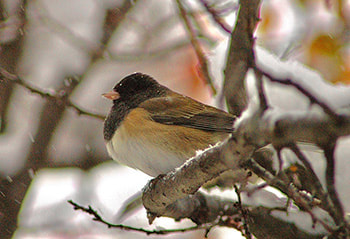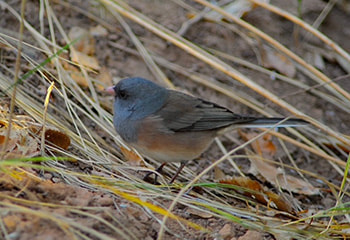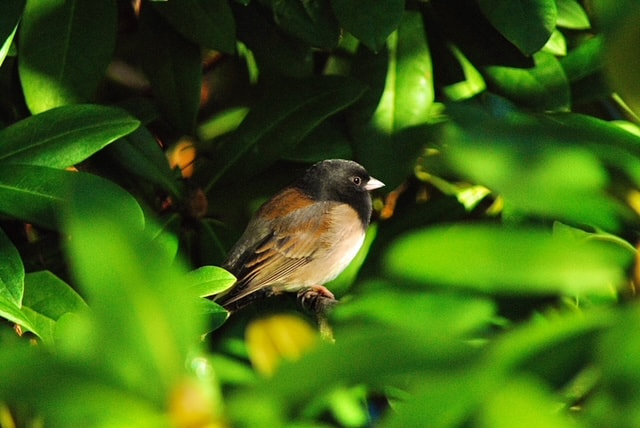|
Juncos in Abiquiu ~ images courtesy of Milo Nikolic  Milo and Junco in Abiquiu Milo and Junco in Abiquiu Milo, the Bondy's grandson, is a budding biologist, or perhaps he will become an ecologist or a wildlife photographer. After his very astute grandparents gave the sixteen year old a camera, Milo began taking pictures of animals and birds all around Abiquiu, and I can attest to the sensitivity of his photography because I have seen it myself, thanks to Carol. I am always excited when I meet a young person (even virtually) who has been swept into the arms of nature on some level. These are the young people that give us hope. We have not left them with an earth legacy to be proud of, and yet, so many are reaching towards the future with an open heart. I celebrate these young people with every fiber of my naturalist’s being. Milo doesn’t know it yet but he has been given a gift that will help sustain him through, what I hope, will be a long and meaningful life. Nature has a way of supporting us when all else fails. His attraction to the natural world will also provide him with joy as well as turn him into an earth advocate, no doubt. In this picture Milo is holding one of my favorite birds – the junco. The original snowbird, according to John James Audubon (and most sources) because so many of these birds do migrate. The Slate colored junco breeds in forests from Alaska to Newfoundland, north through the boreal forest and south through the Appalachian Mountains to Georgia. The male has a gray head (sometimes closer to black, sometimes tinged brown), chest, back, and wings, and a bright white belly; a female is similar with a paler brown wash. Here in Maine we have the Slate colored junco around during the winter months. During the fall I had a few and now I have none, so some were just passing through. Any day now I expect some Slate colored juncos to arrive for the winter because it will soon be getting colder and real snow (not slop) is somewhere on the horizon.
When I first looked at the photograph I noted that Milo held a Dark eyed junco – but which sub species? I am going to challenge Milo to make a positive identification of the subspecies of the bird he holds in his hand with such focus and reverence. One of the neatest aspects of bird-watching in Abiquiu is that this area often attracts birds from both eastern and western ranges, and those that interbreed often have characteristics belonging to different species. Orioles, in particular, come to mind. What is confusing in terms of identification is that throughout the west there are lots of Dark eyed Juncos! These western varieties breed in different regions, and look so distinct from one another that, until the 1970s, they were considered separate species. All of the juncos I include still mate and apparently interbreed randomly wherever their ranges meet, so they belong to the same species. I write ‘apparently’ because there are some sources that suggest they don’t interbreed as freely as once thought. So? The Oregon Junco is the most widespread and variable subspecies group in western North America. They breed in forest habitats from southern Alaska down to Baja California and east to Nevada. The head of the adult male can vary from black to medium gray, the wings are gray or brownish gray, and the back and sides vary from dark brown to reddish brown to pinkish. The lower belly is white. A female looks similar, with a paler wash. I am quite sure I have had these juncos feeding on the ground in Abiquiu. Pink-sided juncos breed in the high-elevation forests of the northern Rocky Mountains, from southern Alberta to eastern Idaho and western Wyoming, including Yellowstone National Park. Males have a medium-gray head and breast, a dark smudge around their eyes, pinkish sides, brown back and wings, and a white belly. Like other Dark-eyed Juncos, the females are browner than the males. Have I also seen these juncos at my feeders in Abiquiu? I am not sure. Males of the Gray –headed Juncos have a medium-gray head, but also gray sides, chest, and belly, with some white on the lower belly. They have a rusty back and, like the pink-sided junco, gray-headed males have a black smudge around their eyes. They breed in the southern Rocky Mountains from Colorado to central Arizona and New Mexico. White-winged males look similar to the Slate-colored juncos, but they're larger, with a relatively longer bill and tail, and have white wing bars that are sometimes not visible. They also have a lot of white on their tails. They breed in a small geographical area: the Black Hills of South Dakota, a rugged landscape dotted by ponderosa pines. The Red – backed juncos are and rare and live in the southern mountains of Arizona and New Mexico. They have a bi-colored bill—dark gray on top, silvery on the bottom—a gray head, lighter gray throat and breast, gray and rust wings, a red back, and dark eyes, with a dark eye smudge. They are mostly non-migratory. There is also a Dark-eyed junco variety called the Guadalupe junco that only breeds on the tiny island of Guadalupe, which lies off the coast of Baja California. All of these small, round songbirds are easily recognized by their characteristic hops, moving rapidly forward and sideways on the ground especially under feeders. Some flash white tail feathers when they flutter into tall grass or low hanging branches. According to recent DNA evidence the Juncos’ evolutionary story goes back to the retreat of our North American glaciers (10 – 13,000 years ago). The northern half of the US was smothered in ice and when the climate warmed and the glaciers receded unpopulated land was ready for birds to inhabit. Ancestral juncos – probably Yellow eyed – migrated north and spread across the continent. Some groups became isolated enough to evolve new color variations in what scientists now believe is “one of the fastest cases of speciation known in vertebrates”, or at least this is the current theory. The regional junco groups don’t really behave differently although their songs differ to some extent. (I listened to the songs of Slate colored juncos and compared them with those songs belonging to the other Dark eyed juncos and could clearly hear a difference). Juncos all nest on the ground, eat seeds and insects, and hop around enthusiastically. The fact that their behavior hasn’t changed supports the idea that the differences are recent. One genetic change is enough to create a variety of unusual feather colors. But what about the difference in voices? We don’t know what climate change will do to these birds. Will it isolate the groups, or remove current barriers, and what about Audubon’s projection that we will lose 2/3rds of our bird species by the end of the century? Altogether there are about 15 subspecies of Dark eyed juncos but most fit into one of the groups I mention. Most are somewhat migratory, and happily in Abiquiu, it is possible to see more than one sub species concurrently. I’ll be very interested to know what choice Milo makes when he identifies the bird in his hand. I also want to know how this little beauty happened to be there in the first place!
2 Comments
Joanne Holman
12/18/2020 09:22:23 am
Thank you for all your wonderful and informative Observations printed in the Abiquiu News. It was something I looked forward to seeing each week. And I’m glad you are doing what you need for yourself at this time. Take good care...
Reply
Sara M
12/20/2020 01:27:12 pm
This is Milo’s mom, (also) Sara. Thank you for this article! Milo and I enjoyed reading it. He guesses that the junco in his hand—who was a bit stunned and cold from having flown into a window, but who flew away a few moments after this photo was taken—was a female Oregon junco.
Reply
Your comment will be posted after it is approved.
Leave a Reply. |
Submit your ideas for local feature articles
Profiles Gardening Recipes Observations Birding Essays Hiking AuthorsYou! Archives
October 2025
Categories
All
|




 RSS Feed
RSS Feed